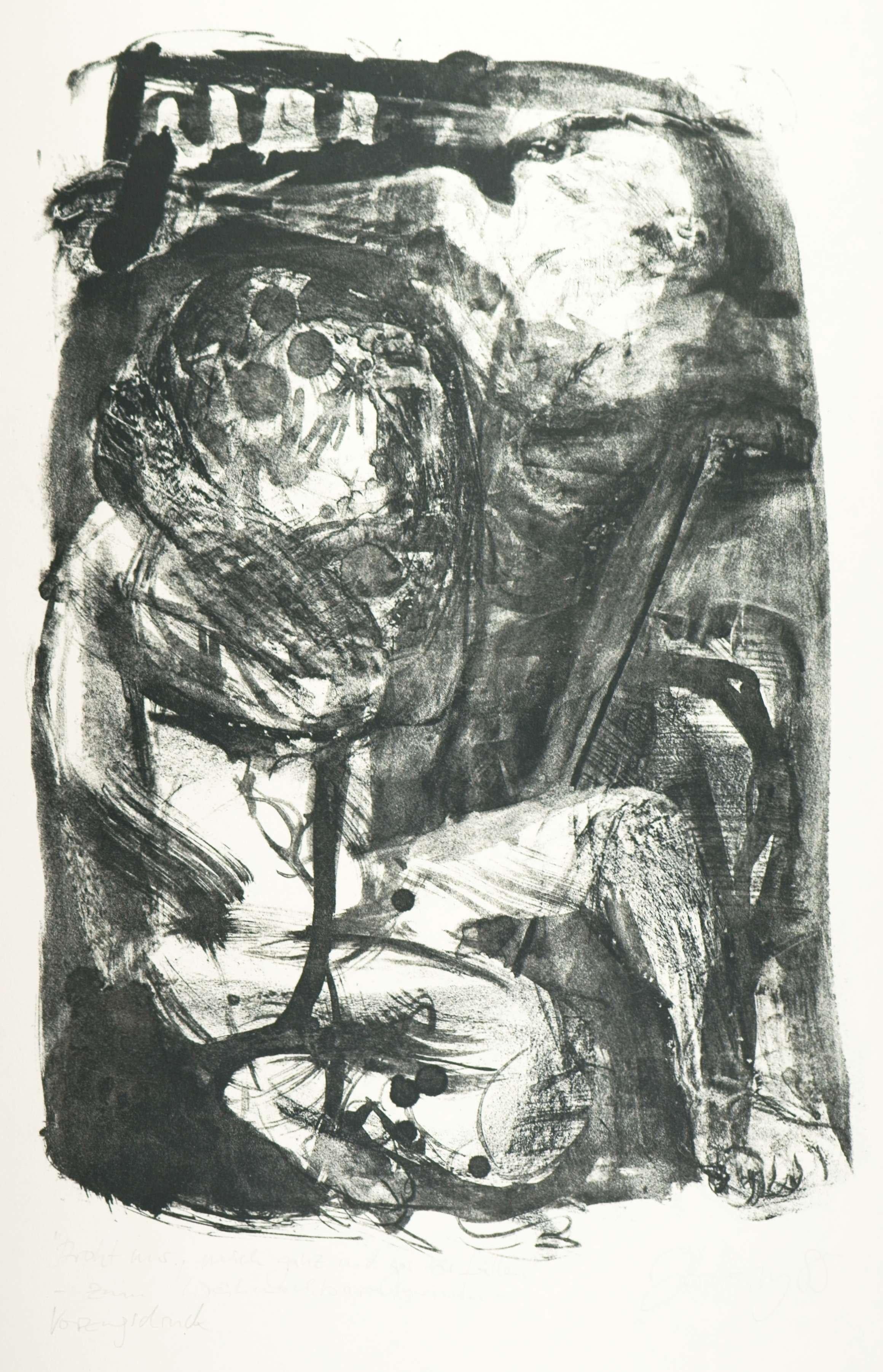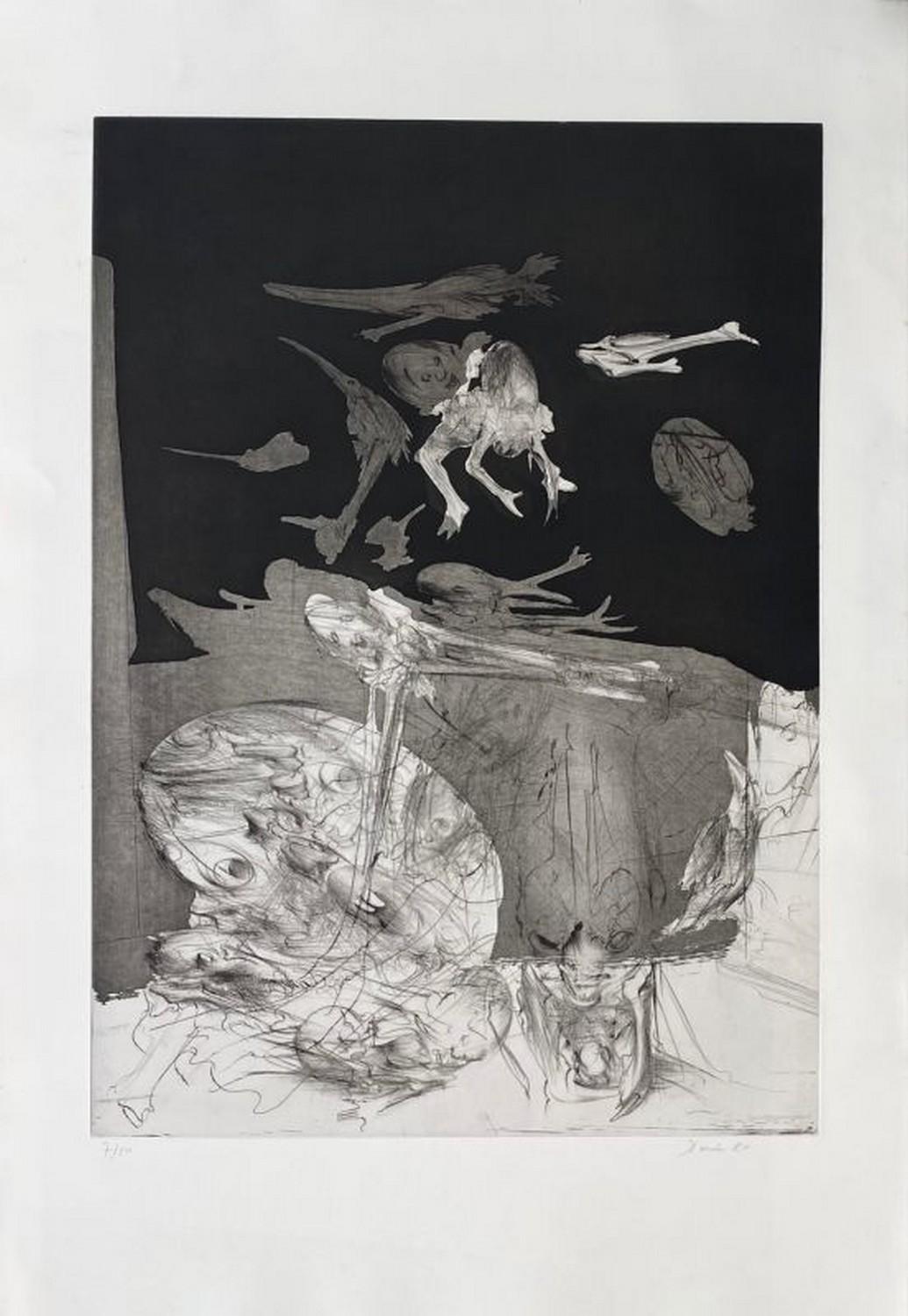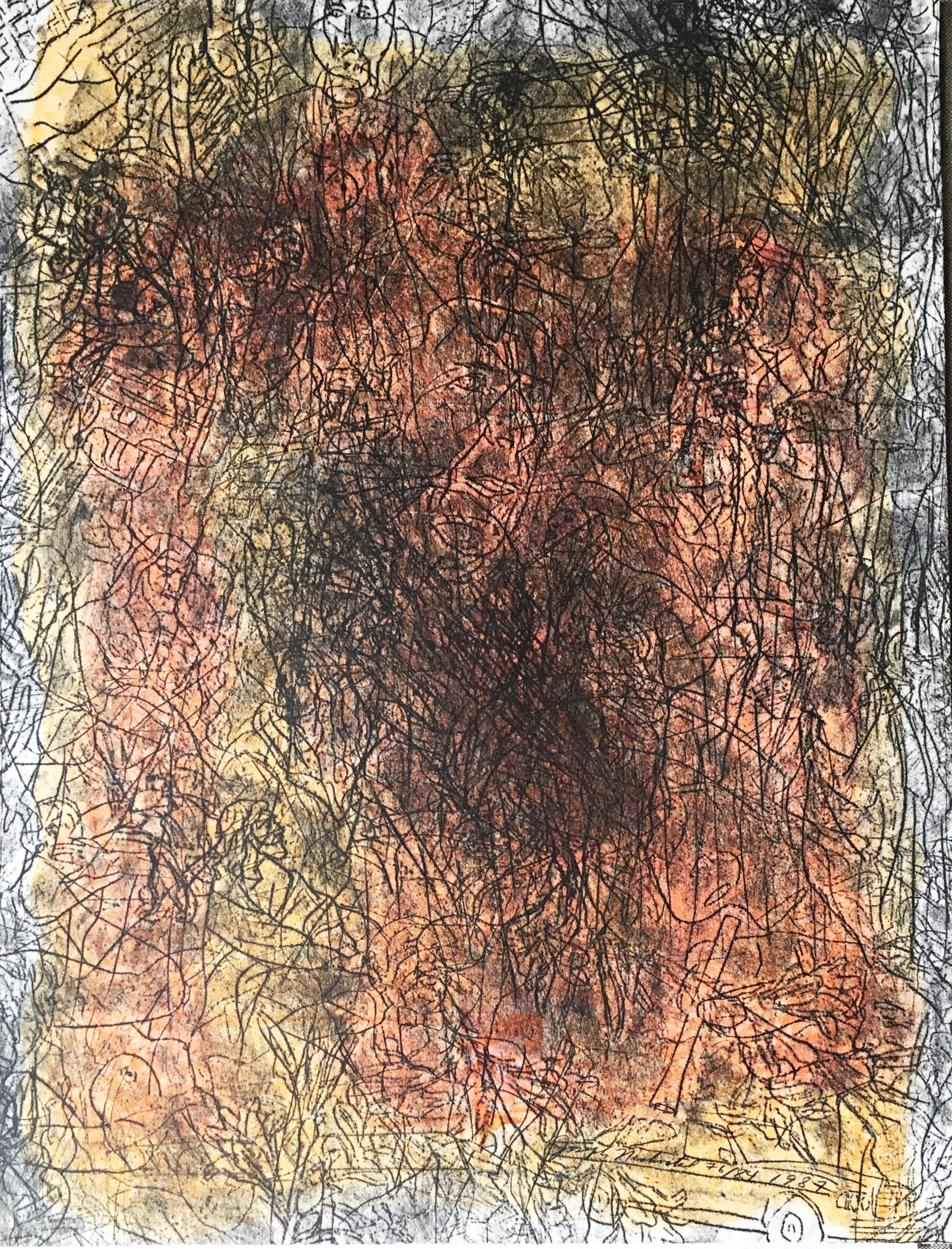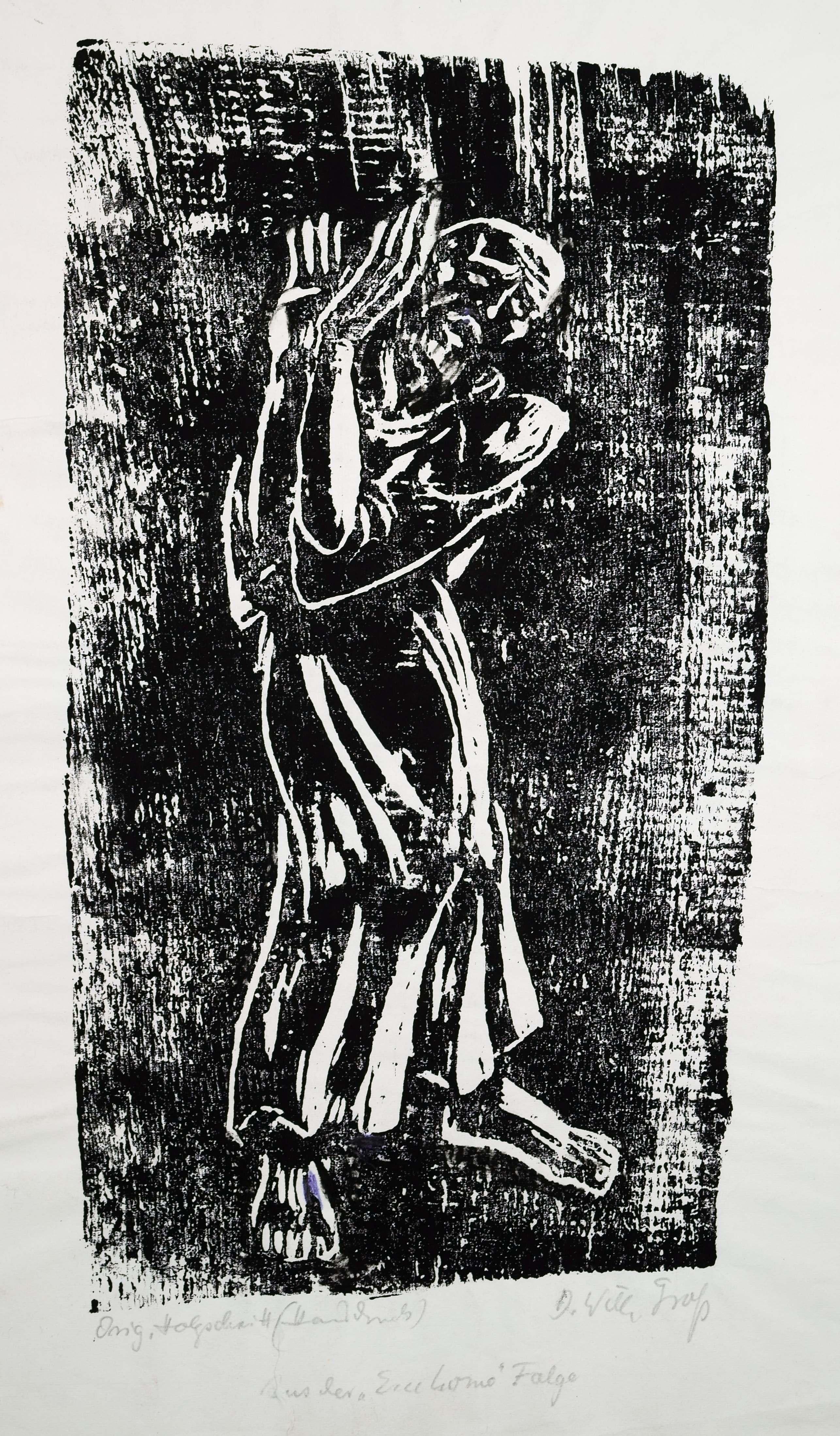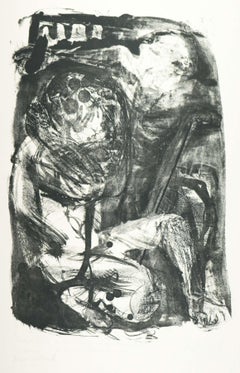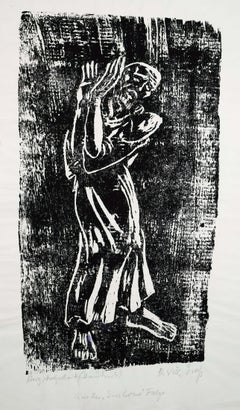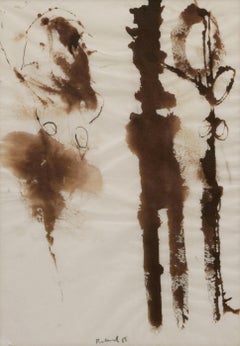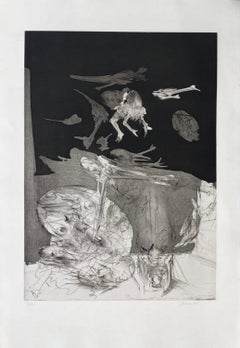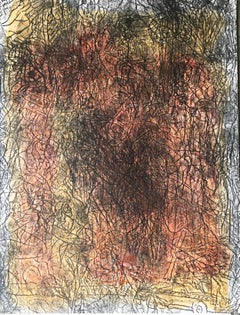Items Similar to My treasure, my sanctuary / - A Tortured Treasure -
Want more images or videos?
Request additional images or videos from the seller
1 of 8
Johannes HeisigMy treasure, my sanctuary / - A Tortured Treasure -1985
1985
$454.93
£340.21
€380
CA$626.87
A$683.89
CHF 362.12
MX$8,195
NOK 4,611.77
SEK 4,217.12
DKK 2,894.15
About the Item
Johannes Heisig (*1953 Leipzig), "My treasure, my sanctuary" - To the Christmas Oratorio by Johann Sebastian Bach. Lithograph on strong yellowish laid paper with watermark, 53 x 39.5 cm (sheet size), signed and hand-dated "Joh[annes]Heisig [19]85" at lower right, hand-inscribed "Mein Schatz, mein Hort - Zum Weihnachtsoratorium" at lower left and handwritten as "Vorzugsdruck".
- light crease marks in lower area, otherwise good copy
- A Tortured Treasure -
About the artwork
Johannes Heisig takes on the artistic challenge of interpreting Johann Sebastian Bach's Christmas Oratorio in a pictorial manner. Probably Bach's most famous sacred composition, it was performed for the first time in 1734/1735 during the Christmas season at the Nikolaikirche and the Thomaskirche in Johannes Heisig's hometown of Leipzig.
Heisig chose the third line from the aria of the sixth and final part of the oratorio, intended for Epiphany: “My treasure, my sanctuary is here with me”.
Now, you arrogant enemies, you may tremble;
what kind of fear can you arouse in me?
My treasure, my sanctuary is here with me.
You may seem still so horrible,
threatening to defeat me once and for all,
yet see! My Savior lives here.
- Christmas Oratorio, 62th Verse.
A large, striding figure with an outstretched arm places his hand on the head of another figure, which can only be guessed at, who stands motionless with his legs overlapping the picture. In addition to the contrast between movement and stillness, the picture's tension is heightened by a contrast between light and dark. The dark striding figure seems to be stepping almost violently into the light figure, covering its eyes with its hand and kicking its sex with its foot, causing the light figure to open its mouth and scream. "My treasure, my treasure" is almost raped here instead of being honored as such, with which Heisig carries the Passion that Christ suffers through all of us into the Christmas Oratorio.
About the artist
Johannes Heisig is the son of Bernhard Heisig and the grandson of Walter Heisig, who were also artists. After studying painting and graphic arts at the HGB Academy of Visual Arts in Leipzig from 1973 to 1977, Johannes Heisig was a master student of Gerhard Kettner at the Dresden Academy of Fine Arts (HfBK) from 1978 to 1980. From 1979 to 1980 he was also a scholarship holder at the F+F School for Art and Experimental Design in Zurich.
In 1980 he began teaching at the Hochschule für Bildende Künste Dresden, where he became a professor in 1988 and served as rector from 1989 to 1991. In 1990 he was one of the founding members of the New Saxon Art Association. Heisig moved to Berlin in 2000. From 2003 to 2004 he was a professor at the TU Dortmund. In 2004, Heisig was a guest artist in Eisennach. In 2015 he moved to Teetz in Kyritz.
Selection of exhibitions
1988 Galerie der Stadt Esslingen am Neckar; Galerie der Universität Dortmund
1994 Kunstverein Wilhelmshaven, Kunsthalle
1995 Kunst- und Kunstgewerbeverein Pforzheim, Reuchlinhau
1996 Caput mortuum, Kunstverein Aschaffenburg, Jesuitenkirche
1997 Museum Kunstscheune Bergsdorf; COMPTOIR Kunstmagazin, Städtische Kunstgalerie, Sonneberg
1999 Galerie Rothamel, Erfurt, Friedrich-Ebert-Stiftung Bonn
2000 Kulturspeicher Oldenburg
2001 Kunstverein Bautzen
2003 Land in Sicht, Thüringer Museum im Marstall des Stadtschlosses Eisenach
2005 Ich geh und suche mit Verlangen, Präsentation der Arbeit als „Stadtgast“ Eisenach, Thüringer Museum Eisenach
2006 Werkretrospektive: Städtische Galerie ADA, Meiningen und Kunststation Kleinsassen
2007 Sichtverhältnisse, Kunst-Kontor Sehmsdorf, Potsdam; Kunstverein Südsauerland, Olpe
2008 Es war einmal, Abgeordnetenhaus von Berlin
2009 3 Berliner, Deutsche Botschaft London
2011 Übergände, Ausstellungstriptychon in Willy-Brandt-Haus, Galerie son und SEZ, Berlin
2012 Johannes Heisig – augenscheinlich, Einzelausstellung im Kunstverein Coburg, Coburg
2015 Angesicht, Einzelausstellung mit Malerei und Zeichnungen Heisigs im Marburger Kunstverein
2015/2016 Monologe, Galerie Himmel, Dresden
2016 Mach Dir ein Bild!, Die Galerie, Frankfurt am Main
2017 ... parallel zur Natur, Galerie Himmel Dresden
2017 Land in Sicht, Galerie Berlin
2017 Klimawechsel, Kunsthalle Jesuitenkirche Aschaffenburg
2018 Klimawechsel, Kunst Freunde Pritzwalk e.V. Museumsfabrik Pritzwalk
2018 Tonlagen, Brandenburgisches Landesmuseum für moderne Kunst, Cottbus
2018 Selbstbefragungen, Grafikmuseum Stiftung Schreiner Bad Steben
2018 Und das Zentrum ist der Mensch, Galerie Z, Landau
2018 Beteiligung bei Zu Fontane 200, Landtag Brandenburg, Potsdam
2019 Klimawechsel, Osthaus Museum Hagen
2019 Beteiligungen bei Point of no return, MdBK Leipzig und Land schafft Kunst VII zu Fontane, Neuwerder
2019 Herbstfeuer, Die Galerie, Frankfurt am Main
2020 Paragone, mit Sylvia Hagen in der Galerie Himmel, Dresden
2020 weitere Einzelausstellungen im Schloss Ribbeck, im Kunstverein Schloss Wiligrad bei Schwerin sowie eine Beteiligung in der Galerie Berlin
2020/2021 Denn unversiegbar ist der Bronnen, Arbeiten zu Richard Wagner, Richard-Wagner-Stätten Graupa
2021 Beteiligung bei Hrdlicka. Grütze, Heisig - Die Sammlung Steinfeld, Galerie Himmel, Dresden
Films
2000 Filmporträt „Ende der großen Belehrung“ arte/ ZDF
2002 Film „Dorfbild mit Aposteln“ arte/ NDR
2008 DVD „Es war einmal“ Ein Film von Ingo Steinbach, Musik Ulrich Gumpert, Text Jochen Berg
Awards
2020 Kunstpreis des Landes Brandenburg
Selected Bibliography
Tatjna Frey (Hrsg.): Johannes Heisig. Malerei und Grafik, Dresden1990.
Ulrike Damm (Hrsg.): Johannes Heisig, Berlin 1996.
Hasso von Poser (Hrsg.): Das Gelliehäuser Altarbild von Johannes Heisig, Karlsruhe 2003.
Stadtverwaltung Eisenach (Hrsg.): Ich geh und suche mit Verlangen, Eisenach 2005.
Arnd Brummer (Hrsg.): Blaise Pascal. Gedanken, Leipzig 2007.
Georg Trakl. Gedichte (= Die graphischen Bücher. Band 34), Leipzig 2008.
Mihyun Son (Hrsg.): Johannes Heisig „es war einmal“, Berlin 2008.
Hermann Glaser (Autor), Johannes Heisig (Illustrator): Das Gespräch mit einer Forelle ist schon was wert, Halle 2012.
Michael Hametner: Übermalen. 15 Gespräche - ein Porträt des Malers Johannes Heisig, Halle 2017.
Elisabeth Dieterle (Hrsg.): Johannes Heisig – Klimawechsel, München – London - New York 2018.
GERMAN VERSION
Johannes Heisig (*1953 Leipzig), „Mein Schatz, mein Hort“- Zum Weihnachtsoratorium von Johann Sebastian Bach. Lithographie auf starkem gelblichem Büttenpapier mit Wasserzeichen, 53 x 39,5 cm (Blattgröße), unten rechts mit „Joh[annes]Heisig [19]85“ handsigniert und handdatiert, unten links mit „Mein Schatz, mein Hort - Zum Weihnachtsoratorium“ handbezeichnet und handschriftlich als „Vorzugsdruck“ ausgewiesen.
- leichtere Knickspuren im unteren Bereich, sonst gutes Exemplar
- Ein gequälter Schatz -
zum Kunstwerk
Johannes Heisig stellt sich der künstlerischen Herausforderung, das Weihnachtsoratorium von Johann Sebastian Bach bildlich zu interpretieren. Die wohl berühmteste geistliche Komposition Bachs wurde erstmals zur Weihnachtszeit 1734/1735 parallel in der Nikolaikirche und der Thomaskirche in Johannes Heisigs Geburtsstadt Leipzig aufgeführt.
Heisig wählt hier die dritte Zeile aus der Arie des für das Epiphaniasfest vorgesehenen sechsten und letzten Teils des Oratoriums: „Mein Schatz, mein Hort ist hier bei mir!“.
Nun mögt ihr stolzen Feinde schrecken;
Was könnt ihr mir für Furcht erwecken?
Mein Schatz, mein Hort ist hier bei mir!
Ich mögt euch noch so grimmig stellen,
Droht nur, mich ganz und gar zu fällen,
Doch seht! mein Heiland wohnet hier.
- Weihnachtsoratorium BWV 248, 62. Strophe
Eine große ausschreitende Gestalt mit ausgestrecktem Arm legt seine Hand auf das Haupt einer weiteren einzig zu erahnenden Gestalt, die bewegungslos dasteht und deren Beine das Bild überschneiden. Neben dem Gegensatz von Bewegung und Bewegungslosigkeit wird die Bildspannung durch einen Hell-Dunkel-Kontrast gesteigert. Die dunkle ausschreitende Gestalt scheint fast gewaltsam in die helle Gestalt hineinzuschreiten und ihr dabei mit der Hand die Augen zuzuhalten und mit dem Fuß ins Geschlecht zu treten, so dass die helle Gestalt den Mund zum Schrei geöffnet hat. „Mein Schatz, mein Hort“ wird hier beinahe vergewaltigt, anstatt ihn als solches zu würdigen, womit Heisig die Passion, die Christus durch uns alle erleidet, mit ins Weihnachtsoratorium hineinträgt.
zum Künstler
Johannes Heisig ist der Sohn von Bernhard Heisig und Enkel von Walter Heisig, die ebenfalls Künstler waren. Im Anschluss an das von 1973 bis 1977 währende Studium der Malerei und Grafik an der Hochschule für Grafik und Buchkunst Leipzig (HGB) war Johannes Heisig von 1978 bis 1980 Meisterschüler bei Gerhard Kettner an der Hochschule für Bildende Künste Dresden (HfBK). Von 1979 bis 1980 war er zudem als Stipendiat an der F+F Schule für Kunst und experimentelle Gestaltung in Zürich.
1980 begann seine Lehrtätigkeit an der Hochschule für Bildende Künste Dresden, wo er seit 1988 Professor war und der Heisig von 1989 bis 1991 als Rektor vorstand. 1990 gehörte er zu den Gründungsmitgliedern des Neuen Sächsischen Kunstvereins. 2000 zog Heisig nach Berlin. Von 2003 bis 2004 hatte er eine Professur an der TU Dortmund inne. 2004 war Heisig als ‚Stadtgast‘ Stipendiat in Eisennach. 2015 erfolgte die Übersiedlung nach Teetz in Kyritz.
Auswahl an Ausstellungen
1988 Galerie der Stadt Esslingen am Neckar; Galerie der Universität Dortmund
1994 Kunstverein Wilhelmshaven, Kunsthalle
1995 Kunst- und Kunstgewerbeverein Pforzheim, Reuchlinhau
1996 Caput mortuum, Kunstverein Aschaffenburg, Jesuitenkirche
1997 Museum Kunstscheune Bergsdorf; COMPTOIR Kunstmagazin, Städtische Kunstgalerie, Sonneberg
1999 Galerie Rothamel, Erfurt, Friedrich-Ebert-Stiftung Bonn
2000 Kulturspeicher Oldenburg
2001 Kunstverein Bautzen
2003 Land in Sicht, Thüringer Museum im Marstall des Stadtschlosses Eisenach
2005 Ich geh und suche mit Verlangen, Präsentation der Arbeit als „Stadtgast“ Eisenach, Thüringer Museum Eisenach
2006 Werkretrospektive: Städtische Galerie ADA, Meiningen und Kunststation Kleinsassen
2007 Sichtverhältnisse, Kunst-Kontor Sehmsdorf, Potsdam; Kunstverein Südsauerland, Olpe
2008 Es war einmal, Abgeordnetenhaus von Berlin
2009 3 Berliner, Deutsche Botschaft London
2011 Übergände, Ausstellungstriptychon in Willy-Brandt-Haus, Galerie son und SEZ, Berlin
2012 Johannes Heisig – augenscheinlich, Einzelausstellung im Kunstverein Coburg, Coburg
2015 Angesicht, Einzelausstellung mit Malerei und Zeichnungen Heisigs im Marburger Kunstverein
2015/2016 Monologe, Galerie Himmel, Dresden
2016 Mach Dir ein Bild!, Die Galerie, Frankfurt am Main
2017 ... parallel zur Natur, Galerie Himmel Dresden
2017 Land in Sicht, Galerie Berlin
2017 Klimawechsel, Kunsthalle Jesuitenkirche Aschaffenburg
2018 Klimawechsel, Kunst Freunde Pritzwalk e.V. Museumsfabrik Pritzwalk
2018 Tonlagen, Brandenburgisches Landesmuseum für moderne Kunst, Cottbus
2018 Selbstbefragungen, Grafikmuseum Stiftung Schreiner Bad Steben
2018 Und das Zentrum ist der Mensch, Galerie Z, Landau
2018 Beteiligung bei Zu Fontane 200, Landtag Brandenburg, Potsdam
2019 Klimawechsel, Osthaus Museum Hagen
2019 Beteiligungen bei Point of no return, MdBK Leipzig und Land schafft Kunst VII zu Fontane, Neuwerder
2019 Herbstfeuer, Die Galerie, Frankfurt am Main
2020 Paragone, mit Sylvia Hagen in der Galerie Himmel, Dresden
2020 weitere Einzelausstellungen im Schloss Ribbeck, im Kunstverein Schloss Wiligrad bei Schwerin sowie eine Beteiligung in der Galerie Berlin
2020/2021 Denn unversiegbar ist der Bronnen, Arbeiten zu Richard Wagner, Richard-Wagner-Stätten Graupa
2021 Beteiligung bei Hrdlicka. Grütze, Heisig - Die Sammlung Steinfeld, Galerie Himmel, Dresden
Filme
2000 Filmporträt „Ende der großen Belehrung“ arte/ ZDF
2002 Film „Dorfbild mit Aposteln“ arte/ NDR
2008 DVD „Es war einmal“ Ein Film von Ingo Steinbach, Musik Ulrich Gumpert, Text Jochen Berg
Ehrungen
2020 Kunstpreis des Landes Brandenburg
Auswahlbibliographie
Tatjna Frey (Hrsg.): Johannes Heisig. Malerei und Grafik, Dresden1990.
Ulrike Damm (Hrsg.): Johannes Heisig, Berlin 1996.
Hasso von Poser (Hrsg.): Das Gelliehäuser Altarbild von Johannes Heisig, Karlsruhe 2003.
Stadtverwaltung Eisenach (Hrsg.): Ich geh und suche mit Verlangen, Eisenach 2005.
Arnd Brummer (Hrsg.): Blaise Pascal. Gedanken, Leipzig 2007.
Georg Trakl. Gedichte (= Die graphischen Bücher. Band 34), Leipzig 2008.
Mihyun Son (Hrsg.): Johannes Heisig „es war einmal“, Berlin 2008.
Hermann Glaser (Autor), Johannes Heisig (Illustrator): Das Gespräch mit einer Forelle ist schon was wert, Halle 2012.
Michael Hametner: Übermalen. 15 Gespräche - ein Porträt des Malers Johannes Heisig, Halle 2017.
Elisabeth Dieterle (Hrsg.): Johannes Heisig – Klimawechsel, München – London - New York 2018.
- Creator:Johannes Heisig (1953, German)
- Creation Year:1985
- Dimensions:Height: 20.87 in (53 cm)Width: 15.56 in (39.5 cm)Depth: 0.4 in (1 cm)
- Medium:
- Movement & Style:
- Period:
- Condition:
- Gallery Location:Berlin, DE
- Reference Number:1stDibs: LU2438212833922

About the Seller
5.0
Vetted Professional Seller
Every seller passes strict standards for authenticity and reliability
Established in 2014
1stDibs seller since 2023
23 sales on 1stDibs
- ShippingRetrieving quote...Shipping from: Berlin, Germany
- Return Policy
More From This Seller
View AllThreatening to defeat me once and for all / - A Christmas Pietà -
Located in Berlin, DE
Johannes Heisig (*1953 Leipzig), "Threatening to defeat me once and for all" - To the Christmas Oratorio by Johann Sebastian Bach. Lithograph on strong yellowish laid paper with wate...
Category
1980s Abstract Expressionist Figurative Prints
Materials
Lithograph
The Prophet / - The Burden of the Prophet -
Located in Berlin, DE
Wilhelm Gross (1883 Schlawe - 1974 Oranienburg-Eden), The Prophet, c. 1955. Woodcut on thin laid paper, 43 cm x 23 cm (depiction), 61 cm x 43 cm (sheet size), signed “Dr. Wilh.[elm] Gross” in pencil lower right, inscribed “Orig.[inal] Holzschnitt (Handabdruck)” lower left and inscribed “Aus der ”Ecce homo“ Folge” in the center.
- The wide margin with traces of pressing due to the impression, the sitter's left foot with a small purple stain, otherwise in vibrant condition.
- The Burden of the Prophet -
The large-format woodcut shows a prophet figure that takes up almost the entire height of the sheet. However, instead of seeing something in the distance that is still hidden from our eyes - as is usual in depictions of prophets - the figure has raised his hands in a defensive gesture, as if the prophet is trying to ward off what he has seen. At the same time, however, the position of the arms is an acceptance of the inevitable, which only those who recognize what is to come will have to bear for the time being, which is why the figure in the painting - despite its size - appears almost solitary, alone and exposed to the burden of suffering.
In a manner reminiscent of the folds of medieval wooden sculptures...
Category
1950s Realist Figurative Prints
Materials
Paper
Untitled / - The archaism of nature -
Located in Berlin, DE
Jorge Machold (1940 Chemnitz - 2015 Berlin), Untitled, 1973. Color etching, 41.5 x 29.2 cm (plate size), 49.5 cm x 39.5 cm (sheet size), signed lower right in lead “J.[orge] Machold”...
Category
1970s Abstract Abstract Prints
Materials
Paper
Untitled / - Association -
Located in Berlin, DE
Detlef Baltrock (*1954 Stuttgart), Untitled, 1985. Watercolor, 29.5 cm x 21 cm (visible dimensions), 41 cm x 32 cm (frame), signed “Baltrock” lower center and signed “[19]85”, label ...
Category
1980s Abstract Expressionist Abstract Drawings and Watercolors
Materials
Paper
The Hunchback / - Strange beauty -
By Reiner Schwarz
Located in Berlin, DE
Reiner Schwarz (*1940 Hirschberg), The Hunchback, 1969. Lithograph, 33 cm x 22 (depiction), 59 cm x 42 cm (sheet size), signed “R.[einer] Schwarz” in pencil lower right, dated “[19]6...
Category
1960s Surrealist Figurative Prints
Materials
Paper
Tectonic Tension / - Archetypes of Painting -
Located in Berlin, DE
Jürgen Möbius (*1939 Großenhain), Tectonic Tension. Oil on hardboard, 47.5 x 60 cm, 49 x 61.5 cm (frame), signed lower right "Möbius" and dated "[19]81".
- Upper left corner with a small chip, light scratches and a little rubbed in places. Provisional gallery frame with traces of use.
- Archetypes of Painting -
About the artwork
The form structure in front of the eye is overlapped by the frame. Thus, the frame does not open up a space in which something is presented, but rather shows the seemingly arbitrary section of a comprehensive context that cannot be framed as such.
We see forms that stand in a structure of tension with each other, whereby the individual black and brown forms, which continue almost endlessly beyond the frame, already show a tension in themselves, since they are not only forms, but also surfaces - form surfaces, while the light blue surface ground is at the same time forms that appear as surface forms. The formed surfaces and surface forms are nested within each other and form a structure that encompasses all elements.
The angular arrangement of the black and brown shaped surfaces gives the structure a tectonic character. The tension is thus heightened to the point of paradox, since the black shape at the front is overlapped by the brown shape at the bottom in the center of the picture, which would be impossible in real space. It is precisely through this "paradox" that Möbius demonstrates that the paradoxical is reality within painting. It is, so to speak, the most original possibility of painting, which distinguishes it from the other arts. In combination with the tectonic formations, Jürgen Möbius creates an archaic primordial painting, which, however, should not be confused with the autonomous color and form cosmos of Suprematism à la Kasimir Malevich. Instead of homogeneous, perfectly colored forms, here the colors are deliberately applied unevenly, and the light blue is mixed with the brown in a manner determined by the brushstroke. At the edges of the surface forms, the uneven application of paint allows the wood of the unprimed hardboard to show through. In this way, Möbius illustrates that we are dealing with a painting that has been created by an act of painting - an act, however, that takes hold of the original principles of painting and thus realizes painting as such.
About the artist
From 1959 to 1965 Jürgen Möbius studied painting at the University Institute for Art and Work Education in Mainz. He also studied philosophy and art history at the University of Mainz. Afterwards he worked as a freelance artist in Mainz.
At first, Möbius created material reliefs and installations, then, around 1974, he turned increasingly to conceptual art and added cinematic means. During this phase he wrote the manifesto-like essay "Principles of Supranatural Landscape" (1979).
From 1981 on, Möbius concentrated on painting and searched for artistic ways to "treat intellectual and sensual perception equally in the fusion of representational and abstract pictorial elements" (Wolfgang Zemter). He found inspiration on his study trips to Thailand and Sri Lanka.
"The pure painting of Jürgen Möbius flows through us as a timeless expression of memory and energy, ploughing our perception and bringing us the happiness of seeing authentic, immovable form.
- Philippe Büttner
Selection of solo exhibitions
1969 Galerie Würzner, Düsseldorf / Galerie Gurlitt, Mainz
1972 Städtische Galerie, Mainz
1973 Galerie Schloss Ringenberg Rathaus, Kleve
1974 Röderhausmuseum, Wuppertal
1976 Galerie Glasing, Osnabrück / Städtische Galerie, Herne
1977, 1997, 2004 Märkisches Museum, Witten
1979 Studio M, Bamberg / Staatstheater, Darmstadt
1980 Galerie Stolànovà, Wiesbaden / Mittelrheinmuseum, Koblenz
1982 Galerie Dornhöfer, Mainz
1984 Galerie Neumühle, Schlangenbad
1985 Landesmuseum, Mainz / Kunstverein, Ludwigshafen / Nassauischer Kunstverein, Wiesbaden
1986 Museum, Bochum / Galerie der Stadt Iserlohn
1987, 1990 Galerie Klaus Kiefer, Essen
1987, 2000 Galerie Ulrike Buschlinger, Wiesbaden
1988 Kunsthalle Darmstadt
1988, 1992, 1996, 1999 Galerie Leonhard, Basel
1992, 2002 Galerie Zulauf, Freisheim
1994 Galerie Remy, Vallendar
1995 Sendezentrum des Zweiten Deutschen Fernsehens, Mainz
2001 Collegium oecumenicum, Bamberg / MVB Forum für Kultur und Wirtschaft, Mainz
2006 Adam Gallery, London
Selection of group exhibitions
1969 ‘International Graphic Arts’, Galerie Dalléas Bordeaux, Paris
1975 ‘Deutscher Künstler-Bund’, Dortmund
1979 ‘Man and man’s Images’, Märkisches Museum Witten
1980 ‘Love-Dokuments of our Time’, Art Hall Darmstadt and Art Association Hannover
1982 ‘Work - Progress – Position’, Nassau Art Association Wiesbaden
1983 ‘Principle Hope – Utopic Aspects in Art and Culture of the 20th Century’, Museum Bochum
1986 ‘Selfportraits’, Gallery Klaus Kiefer Essen
1987 ‘The Dying and Death’, Gallery Klaus Kiefer Essen
1989 ‘Where are You, Revolution – Freedom, Liberty, Egality, Fraternity to-day’, Museum Bochum 1990 ‘Flight – a Problem within the Memory of Man’, Kunsthalle Darmstadt ‘Art and War 1939 – 89’, House of Cultures Berlin
1991 ‘Material and Form’, Pillnitz Castle Dresden and Pfalz Gallery Kaiserslautern
1995 20 Years Exhibitions, Chrämerhuus Langenthal, Schweiz
1998 ‘Works on Paper’, Klaus Kiefer Gallery Essen
2000 ‘Acquisitions 1900 – 2000’, Mittelrhein-Museum Koblenz
2001 ‘Strange Pictures’, Klaus Kiefer Gallery Essen
2002 ‘10 Years Buschlinger Gallery’, Buschlinger Gallery Wiesbaden
2004 ‘Eternal Space – Pictures and Sculptures’, Dome of Bamberg
2005 Art Fair Chicago, Adam Gallery, London
Selected Bibliography
Mittelrheinisches Landesmuseum (Hrsg.): Jürgen Möbius - Neue Bilder, Mainz 1985.
Kunstverein Darmstadt (Hrsg.): Jürgen Möbius. Bilder 1985 - 1988. Kunsthalle Darmstadt, 26. Juni - 14. August 1988. Red. Dorit Marhenke, Lyrik Marcus Schiltenwolf, Düsseldorf 1988.
Gabriele Prusko (Hrsg.): Jürgen Möbius. Mit Texten von Philippe Büttner und Ralph Mieritz, Basel 1992.
Wolfgang Zemter (Hrsg.): Jürgen Möbius - Aktuelle Arbeiten. Märkisches Museum der Stadt Witten, Bönen 1999.
Wolfgang Zemter (Hrsg.): Jürgen Möbius. Flieger in meinem Zimmer und Beruhigte Zone, Bönen 2004.
Dama Gallery...
Category
1980s Abstract Abstract Paintings
Materials
Oil
You May Also Like
Untitled
By Charles Eckart
Located in San Francisco, CA
This artwork "Untitled" 1977, is an original etching on Wove paper by noted American artist Charles Eckart, b.1935. It is hand signed, dated and numbered 7/50 in pencil by the artist...
Category
21st Century and Contemporary Abstract Expressionist Figurative Prints
Materials
Etching
You Live With It I
By Barbara Wagner
Located in Brecon, Powys
21 x 24cm on Somerset paper. They are collagraph and carborundum prints with monoprint background.
Category
2010s Abstract Abstract Prints
Materials
Parchment Paper
Untitled
By Dado (Miodrag Djuric)
Located in Paris, FR
Engraving, 1980
Handsigned by the artist in pencil and numbered 7/50
91.00 cm. x 63.00 cm. 35.83 in. x 24.8 in. (paper)
69.00 cm. x 50.00 cm. 27.17 in. x 19.69 in. (image)
LCD5992
Category
1980s Abstract Abstract Prints
Materials
Engraving
Thou Shalt Not Make Graven Images (The Second Commandment), Lithograph Signed/N
Located in New York, NY
Joseph Nechvatal
Thou Shalt Not Make Graven Images (The Second Commandment), 1987
3 Color lithograph on Arches paper with deckled edges
Signed and numbered from the limited edition of 84 on the front
24 × 18 inches
Unframed
This three color lithograph on Arches paper with deckled edges is pencil signed, dated and numbered from the limited edition of 84. This classic Nechvatal print was created as part of the 1987 portfolio "The Ten Commandments", in which ten top Jewish American artists were each invited to choose an Old Testament commandment to interpret in contemporary lithographic form. The "Chosen" artists were, in order of Commandment: Kenny Scharf, Joseph Nechvatal, Gretchen Bender...
Category
1980s Abstract Abstract Prints
Materials
Lithograph
Untitled
Located in Barcelona, BARCELONA
The painting is being offered with a work and authenticity certificate
Category
1980s Abstract Abstract Prints
Materials
Engraving
Untitled I
By Francisco Maringelli
Located in San Francisco, CA
This artwork titled "Untitled I" 1995 is an original woodcut on thin Japan paper by Brazilian artist Francisco Jose Maringelli, b.1959. It is hand signed and numbered 1/30 in pencil by the artist. The image (block mark) size is 13.85 x 8.75 inches, sheet size is 20.5 x 16.25 inches. It is in excellent condition, has never been framed.
About the artist:
Education:
Bachelor Fine Arts, ECAUSP (1984-1989) and Architecture FAUUSP (1979-1985).
Professor at Centro Universitário Belas Artes de São Paulo
Main Exhibitions:
2018 CONTRAGOLPES; obras recentes de Biba Rigo, Cláudio Caropreso e Francisco Maringelli, São Paulo(SP)
Graphias quinze anos, São Paulo(SP)
2017 ROSTOS LAVRADOS-XILOGRAVURAS,Museu Casa da Xilogravura, Campos do...
Category
Late 20th Century Expressionist Figurative Prints
Materials
Woodcut
